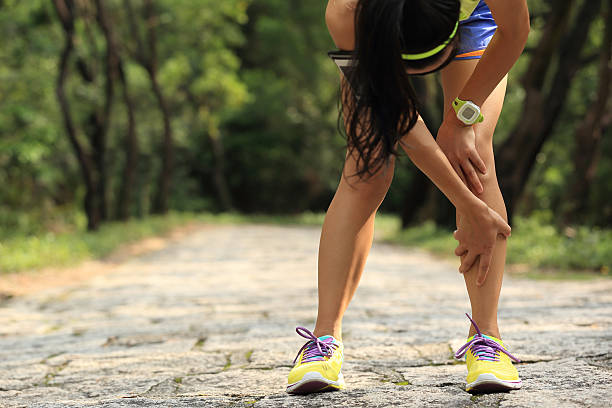Running is one of the most popular fitness activities in the US. Millions of people run for fun, for exercise and run races competitively. Whatever reasons people have for running, and no matter what distance they run, people often end up with hurting themselves. Injuries in new runners can turn them off to the sport. With experienced runners, injuries can derail their training and can make running painful or impossible to do. Many times a running injury results from the way we run, our running mechanics, and making a few small changes can decrease pain and increase performance. The good news is running injuries are preventable and if they do happen, they are treatable.
WHY DO INJURIES HAPPEN?
Any runner can experience an injury due to faulty running mechanics.
If you’ve ever watched a race on TV or read an article about running, you’ll see and hear things like heel strike, stride length, and cadence, all of which are part of your running mechanics. If a runner’s mechanics are not ideal it can cause increased stress on joints, muscles, tendons and ligaments, leading to injury.
But how do you know what the right running mechanics are? And are they the same for all runners? The answer to that is no. Running mechanics are specific to the runner. Below are four basic things to take into consideration when looking at running mechanics.
Four simple steps to good form
- Posture: – Are you slouching and causing stress on your back? Are your arms and shoulders relaxed?
- Mid-foot strike – Are you over-stretching and running with an excessive heel strike, impacting the ground too hard, causing increased stress on your knees and hips?
- Cadence – 180 steps per minute is the optimal cadence. Do you know yours? Too slow of a cadence can increase stress on your joints and cause pain. Too fast can create over exertion and increased strain on your muscles and tendons.
- Lean – Are you leaning too far back or standing too straight up? Both can cause increased stress on your back and create an inefficient run.

Common Running Injuries
- Sprains: Rolling the ankle is the most common running injury, but sprains of the ligaments of the knee are also seen frequently
- Repetitive/Overuse Injuries: Plantar Fasciitis, Shin Splints, and stress fractures
- Tendinitis: Achilles, Posterior Tibialis, and Patellar Tendinitis are the three most common forms of tendinitis seen in runners
- Muscle Strains: Hamstring, Quadriceps, Gastroc/Soleus (Calf), and Iliopsoas (hip flexor) strains are often seen when we have over dominance of certain muscle groups and under recruitment in others, creating muscle imbalances.
BEST TREATMENT FOR RUNNING INJURIES
The best practices for treatment of running injuries vary widely depending upon the type and location of injury, but many cross over and are good for a majority of injuries. These are some of the most commonly utilized treatments for running injuries:
- RICE: Rest, Ice, Compression, and Elevation. The tried and true method for acute treatment of most injuries should continue to be step #1 for any runner or athlete who injuries themselves. This will help to control the acute symptoms and reduce swelling.
- Mobilize The Area: Too many people are too afraid to move through any pain/inflammation and instead immobilize an area. Remember though, acute inflammation, swelling, and irritation can often be made worse by not moving a joint or allowing a tendon or ligament to bind down and tighten further after being over worked. (DISCLAIMER: If you feel you have an actual fracture, that should be assessed through proper imaging and may require immobilization to allow for proper healing).
- Stretch: With issues like tendinitis and muscle strains, we need to length the tissue to allow for proper healing to occur. Yes, the area may feel tight, stiff, and maybe even a little sore, but don’t let the tissue shorten down, making it even harder to move the next day.
- Cross Training:How about we stop injuries before they start? Runners all move in a straight plane movement. Very rarely do runners train in lateral and rotational movements. Reality is, a wide range of movements and strengthening will help to stabilize your joints, ligaments, and tendons while running and not only reduce the strain places on them, but also increase stability and performance.

Don’t let running injuries keep you off the road, get your movements assessed by a trained physical therapist who can help keep you moving at your peak.A physical therapist can help you determine what the correct running mechanics are for you! Wouldn’t it be great to determine if you have faulty mechanics, or if you can improve on your mechanics BEFORE you get injured? Come see us for an orthopedic running assessment!
Erin Magherty, PTA is a graduate of the Naugatuck Valley Community College Physical Therapist Assistant program. She spent many years volunteering at Gaylord Hospital in her hometown of Wallingford and has worked in an outpatient orthopedic setting for 2 years. She also has a Bachelor’s degree in History/Education from Central Connecticut State University. Erin has special interest in the treatment of orthopedic and athletic injuries. She is also interested in integrative health and healing. To contact Erin about your running needs, call (203) 389-4593 or visit www.amitypt.com


